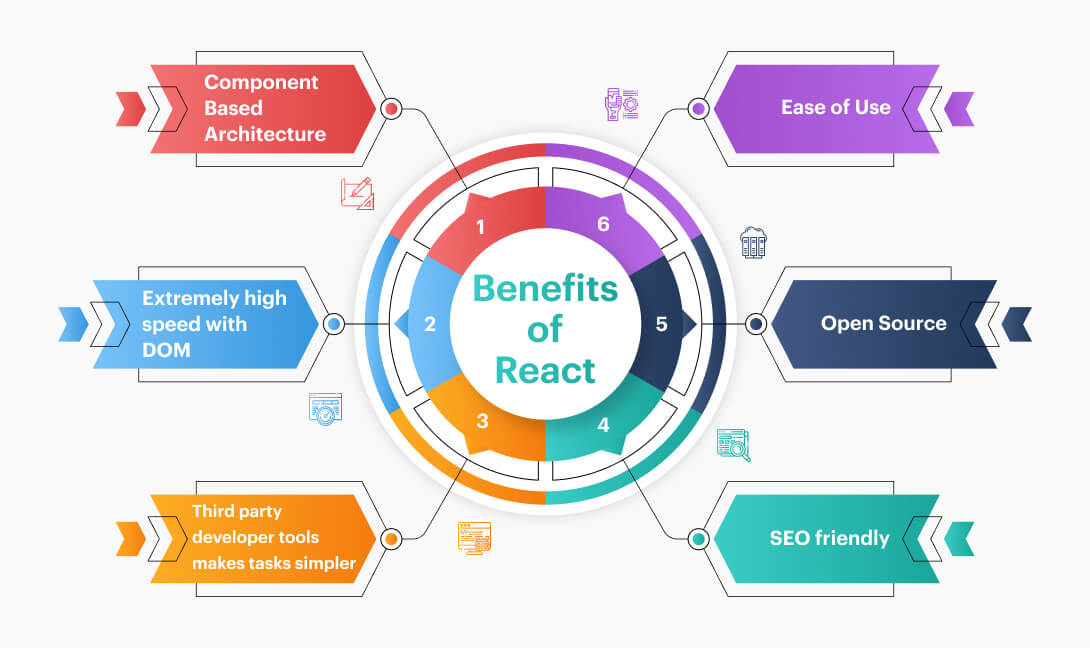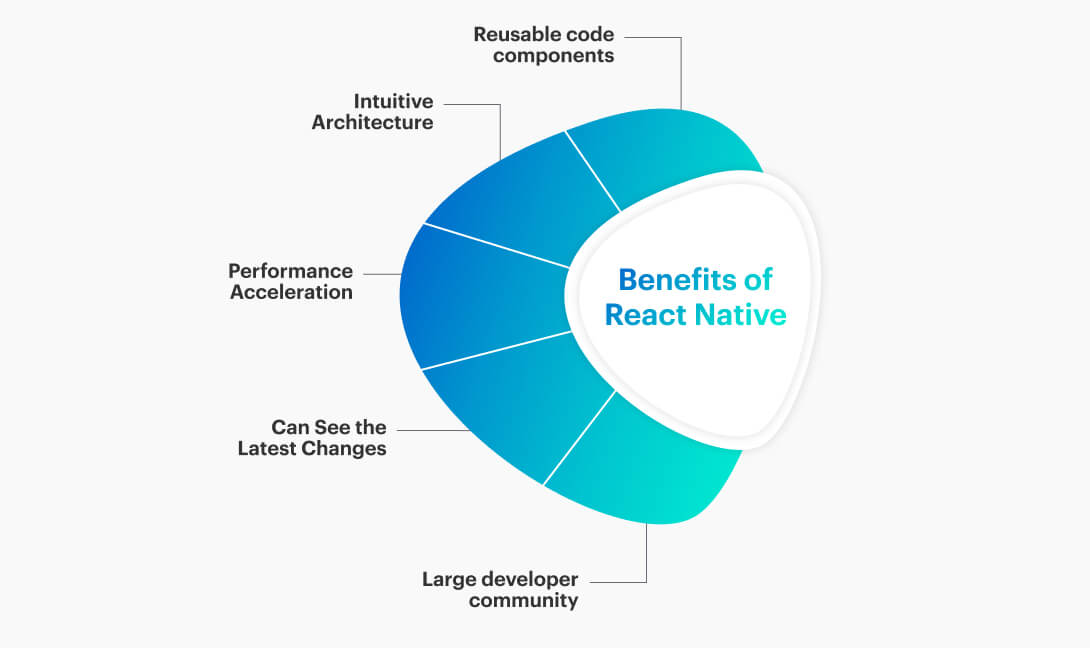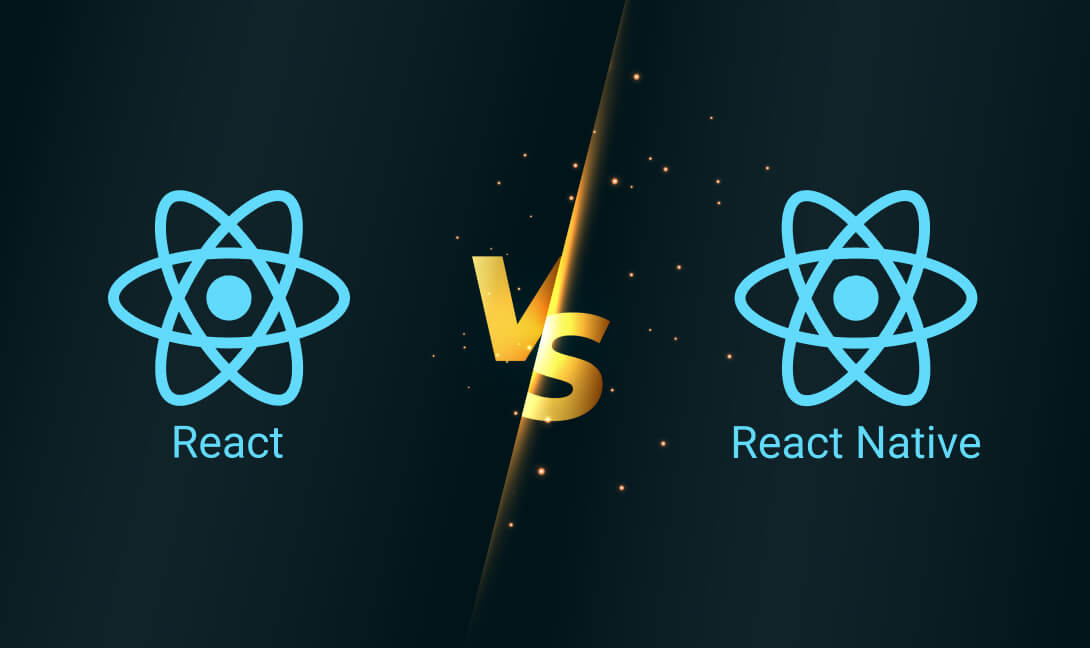React Vs React Native: Intro
React and React Native, both are Javascripts introduced by Facebook with an intention to provide a seamless experience to its users. With the high influx of Facebook users, the company needed to transform its User Interface(UI) to ensure smooth running of the application. Facebook first introduced React to improve its UI performance; however, later React Native (which was derived from React) came into existence. React Native was solely introduced to provide hassle free UI for mobile applications.
Let’s dig deeper into what is reactjs vs reactnative, their usage and much more.
What is React?
React is an open-source javascript library that is used for front-end development to create a fast and smooth user interface for web applications. React framework creates components using Javascript to build intuitive and interactive UIs. It allows you to pick what you need and add it to the code directly.
Benefits of React
Here are some of the most well-known react pros you must be aware of:

Component-based architecture
Component based architecture contains several components (pieces of user interface) that can be directly changed, updated and rendered which saves ample time.
Extremely high speed with DOM
One of the biggest advantages of working with react.js is that it has extremely high speed that makes the web application smooth. React creates an in-memory cache that helps in displaying the browser seamlessly. Also, applications created from React are easy to test as they easily prompt live errors.
Third party developer tools make tasks simpler
React has a wide range of third party tools, libraries, web browsers and extensions that makes the work easier and saves a lot of time. Moreover, the react developer tool is specifically designed to inspect hierarchies of React components. One can easily select and edit a particular component.
SEO friendly
Javascript being hard to read by the search engines has posed many issues for web developers. ReactJs eliminates all such issues because it supports client side rendering and server side rendering. Therefore it can be easily crawled and navigated by different search engines.
Expand your business with our offshore resources
Limitations of React
React Native has its own set of limitations which are as follows:
Use of other languages required
React is only used for UI, hence we require other languages to build the entire application. Only React couldn’t be used to create the entire application.
Difficult to match the pace
React has a very dynamic environment that updates continuously. These constant changes make it difficult for the developers to adapt to them quickly. The pace with which the updates occur creates a hassle for developers to learn new methodology.
Hard to maintain documentation
React keeps updating quite often which makes documentation a tedious task for the developers. Therefore, as soon as there is a new release, developers write instructions right away.
JSX – A barrier
JSX is a syntax extension to make HTML and Javascript work together. It is a bit complex to understand due to which new developers find it hard to implement.
What is React Native?
React Native is also a Javascript framework for ios and android mobile applications. Where React is used to create web UI, React Native is utilized to build mobile UIs. However, both React and React Native use Javascript and XML markup, JSX. Applications built on React Native also access phone features like camera, GPS, etc.
Benefits of React Native

Reusable code components
For React Native Application, the same code can be used for iOS and Android. This means huge cost and time saving. Infact, 90% of the code can be reused for any modifications which eliminates the need of big teams and helps in cost saving.
Intuitive architecture
Intuitive interface of React Native helps increase the flexibility of a development team and makes it easy for developers to update the application. Moreover, it is an easily comprehensible language for testing thus saves time.
Performance acceleration
React Native is extremely fast as it uses Graphics Processing Unit(GPU) due to which the speed of the application increases drastically. Even faster than the cross platform hybrid technologies.
Can see the latest changes
React Native has a live reload feature that reflects the latest changes made to the code simultaneously on a live platform. The effects can be immediately reflected on the mobile screen due to code changes.
Large developer community
React Native uses community driven technology thus any difficulty faced by a developer can be easily solved by peer support. React Native developers can also connect with each other to improve their codes. Moreover, it is an open-source platform so anyone can use the technology freely.
Limitations of React Native
Following are the limitations of React Native:
Debugging is difficult
Since React Native applications use Java, Javascript, C++, debugging becomes a tedious process. The developers must have the knowledge of these languages because React Native moves between Javascript and Native Environment.
Frequent updates make framework weak
React Native is constantly updated almost every week. With every new release the developers are required to adjust to the updates and before they do that, there is another change in line. Additionally, developers need to write extra codes for incompatible components. Due to this, the framework becomes immature and loses credibility.
Lacks security
React Native is an open source framework and Javascript that causes a gap in security. It is highly vulnerable to tampering like – cross site scripting, random malicious links and Arbitrary Code Execution(ACE).
Difficult to determine user interface
Mobile apps that have complex features are not created using React Native. Though React Native has a gesture responder and runs all the gestures smoothly, applications that have complex gestures face issues and can’t use React Native.
React vs React Native
Difference between React and React Native

React Native is quite similar to React but there are certain differences that you must know before building native apps.
Here are some of the differences between React and React Native:
| REACT | REACT NATIVE |
| Build a stable and fast user interface for websites | Build a robust and fast mobile application for a variety of operating systems |
| It is an open-source library | It is an open-source framework |
| Saves development time because it uses reusable components and fast rendering | Saves development time with reusable code and pre-built components |
| Uses Javascript library and CSS for animations | Uses built-in animation libraries |
| Uses HTML tags | Doesn’t use HTML tags |
| Uses web platform | Uses Android, AndroidTV, iOS, Windows, UWP, MacOS,web |
| Uses React DOM and CSS for styling | Uses stylesheet and native API’s for styling |
| Single Platform | Cross Platform |
| React-Router is used to navigate web pages | Built-in Navigator library is used |
| High Security | Low Security |
| Uses Local storage | Utilizes AsyncStorage |
| Build APIs for integration of database | Uses Realm |
| CSS can be used for animation | Animation API is used for animation |
| Server side rendering | Not available |
React vs React Native examples
React/ React Js was used for all Facebook products, including the web versions of Insta and Watsapp. React was also used for the revised version of Facebook(Meta). The British news publishing company, BBC and OTT platforms like Netflix also were built on React. Apart from that Asana, Twitter and Uber are some of the popular examples of sites with React Backend.
React Native also has a good user base with brands like Pinterest, Shopify, UberEats, Discord and Coinbase using React Native as its core technology.
To conclude
React is a UI library to create projects for small, large and medium organizations. React is one of the best technologies to use in projects that need frequent user interactions and animations whereas React Native is a UI framework that is used for building mobile applications and defines elements as well as a behavior of the UI subsystem.
FAQs regarding React vs ReactNative
Do I need to know React before working on React Native?
It is advisable to have knowledge of React before using React Native because most of its concepts are based on React. React is an open-source library of Javascript used to create web applications whereas React Native is just a framework of Javascript and is used for mobile applications.
Which technology is better – React or React Native?
It depends on the purpose whether you want to create a web application or a mobile application. Moreover, React Native applications can share the same code for iOS and Android hence it is best to use in case your purpose is to build mobile applications.
Can we use React and React Native together?
You can’t use the entire React code into React Native. You need to develop a UI using React Native components. React and React Native fulfill different requirements, where React is used for Website building, React Native is used for mobile applications hence they can’t be used together.
Do I need to hire separate developers for React and React Native?
If you have Javascript developers you don’t need to hire React or React Native developers separately because React and React Native are based on Javascript.
How to change React to React Native?
To convert React to React Native we need to change the code base which is not easy. Therefore, in order to convert, we need to use Cordova.
Can we use React Native for the Web?
React Native can’t be used for creating web applications because we can only design native components with it, however, with React we only design web components.









